Catalog excerpts
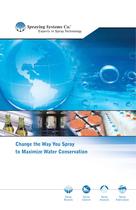
Experts in Spray Technology to Maximize Water Conservation Spray Spray Spray Spray Nozzles Control Analysis Fabrication
Open the catalog to page 1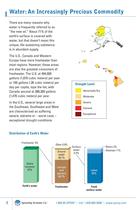
Water: An Increasingly Precious Commodity There are many reasons why water is frequently referred to as “the new oil.” About 71% of the earth’s surface is covered with water, but that doesn’t mean this unique, life-sustaining substance is in abundant supply. The U.S., Canada and Western Europe have more freshwater than most regions. However, these areas are also the greatest consumers of freshwater. The U.S. at 494,000 gallons (1,870 cubic meters) per year or 100 gallons (.38 cubic meters) per day per capita, tops the list, with Canada second at 388,300 gallons (1,470 cubic meters) per...
Open the catalog to page 2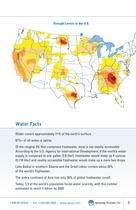
Drought Levels in the U.S. Water Facts Water covers approximately 71% of the earth’s surface. 97%+ of all water is saline. Of the roughly 3% that comprises freshwater, most is not readily accessible. According to the U.S. Agency for International Development, if the world’s water supply is compared to one gallon (3.8 liter), freshwater would make up 4 ounces (0.118 liter) and readily accessible freshwater would make up a mere two drops. Lake Baikal in southern Siberia and the Great Lakes contain about 20% of the world’s freshwater. The entire continent of Asia has only 36% of global...
Open the catalog to page 3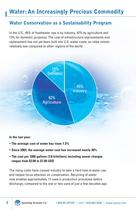
Water: An Increasingly Precious Commodity Water Conservation as a Sustainability Program In the U.S., 45% of freshwater use is by industry, 42% by agriculture and 13% for domestic purposes. The cost of infrastructure improvements and replacement has not yet been built into U.S. water costs, so rates remain relatively low compared to other regions of the world. 13% Domestic 45% Industry 42% Agriculture In the last year: • he average cost of water has risen 7.3% T • ince 2003, the average water cost has increased nearly 30% S • he cost per 1000 gallons (3.8 kiloliters) including sewer charges...
Open the catalog to page 4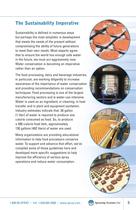
The Sustainability Imperative Sustainability is defined in numerous ways but perhaps the most simplistic is development that meets the needs of the present without compromising the ability of future generations to meet their own needs. Most experts agree that to ensure the world has enough safe water in the future, we must act aggressively now. Water conservation is becoming an imperative rather than an option. The food processing, dairy and beverage industries, in particular, are working diligently to increase awareness of the importance of water conservation and providing recommendations...
Open the catalog to page 5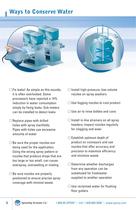
Ways to Conserve Water □ Fix leaks! As simple as this sounds, it is often overlooked. Some processors have reported a 14% reduction in water consumption simply by fixing leaks. Sub-meters can be installed to detect leaks □ Replace pipes with drilled holes with spray manifolds. Pipes with holes use excessive □ Be sure the proper nozzles are being used for the application. Using the wrong spray pattern or nozzles that produce drops that are too large or too small, can cause overspray, overwetting or misting □ Be sure nozzles are properly positioned to ensure precise spray coverage with...
Open the catalog to page 6
□ Divide the spray wash units into two or more sections and establish a counter flow re-use system □ Add handheld spray guns to open hoses to ensure water is "on" only when needed □ As spray equipment wears out, replace with water-saving models □ Equip all hoses with spring loaded shutoff nozzles and ensure they aren't removed □ Use check valves with nozzles to prevent drips and leaks and to maintain line pressure □ Instruct workers to use hoses - equipped with spray guns - sparingly and only when necessary □ Adjust flows from recirculation systems by controlling the rate □ Close filling...
Open the catalog to page 7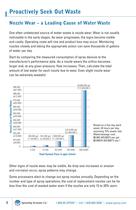
Proactively Seek Out Waste Nozzle Wear – a Leading Cause of Water Waste One often undetected source of water waste is nozzle wear. Wear is not usually noticeable in the early stages. As wear progresses, the signs become visible and costly. Operating costs will rise and product loss may occur. Monitoring nozzles closely and taking the appropriate action can save thousands of gallons of water per day. Start by comparing the measured consumption of spray devices to the manufacturer’s performance data. As a nozzle wears the orifice becomes larger and, at any given pressure, flow increases....
Open the catalog to page 8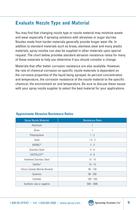
Evaluate Nozzle Type and Material You may find that changing nozzle type or nozzle material may minimize waste and wear especially if spraying solutions with abrasives or sugar slurries. Nozzles made from harder materials generally provide longer wear life. In addition to standard materials such as brass, stainless steel and many plastic materials, spray nozzles can also be supplied in other materials upon special request. The chart below provides standard abrasion resistance ratios for many of these materials to help you determine if you should consider a change. Materials that offer...
Open the catalog to page 9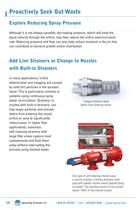
Proactively Seek Out Waste Explore Reducing Spray Pressure Although it is not always possible, decreasing pressure, which will slow the liquid velocity through the orifice, may help reduce the orifice wear/corrosion rate. Reducing pressure and flow can also help reduce moisture in the air that can contribute to bacteria growth and/or distribution. Add Line Strainers or Change to Nozzles with Built-in Strainers In many applications, orifice deterioration and clogging are caused by solid dirt particles in the sprayed liquid. This is particularly common in systems using continuous spray water...
Open the catalog to page 10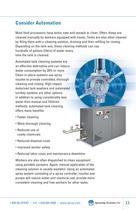
Consider Automation Most food processors have tanks, vats and vessels to clean. Often, these are cleaned manually by workers equipped with hoses. Tanks are also often cleaned by filling them with a cleaning solution, draining and then refilling for rinsing. Depending on the tank size, these cleaning methods can use hundreds of gallons (liters) of water every time the tank is cleaned. Automated tank cleaning systems are an effective alternative and can reduce water consumption by 20% or more. Clean-in-place systems use spray nozzles to provide controlled, thorough cleaning and rinsing....
Open the catalog to page 11All Spraying Systems Co. catalogs and technical brochures
-
G U N J E T® S P R AY G U N S
64 Pages
-
WindJet Air Products
28 Pages
-
Air Atomizing Nozzles
62 Pages
-
Fine Spray Nozzles
16 Pages
-
Hollow Cone Nozzles
42 Pages
-
Flat Spray Nozzles
56 Pages
-
Full Cone Nozzles
52 Pages
-
PWM Spray Control Panel
2 Pages
-
Optimizing Your Spray System
47 Pages
-
AutoJet Gas Cooling System
4 Pages
-
PWM Flow Control
2 Pages
Archived catalogs
-
CU150A GunJet Spray Gun
2 Pages

































